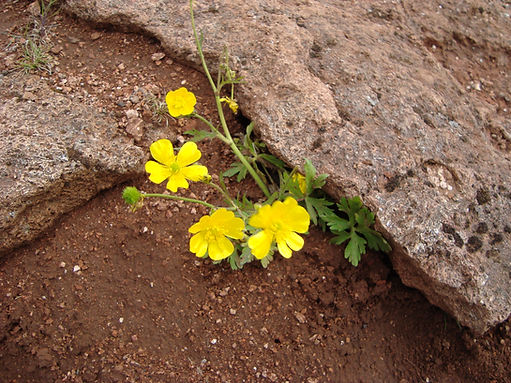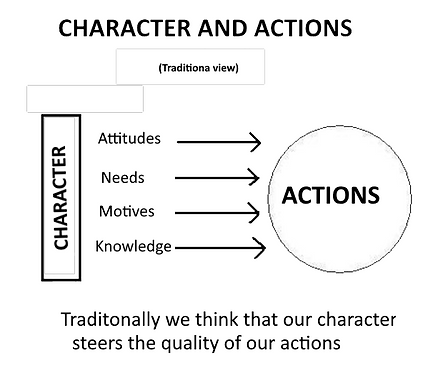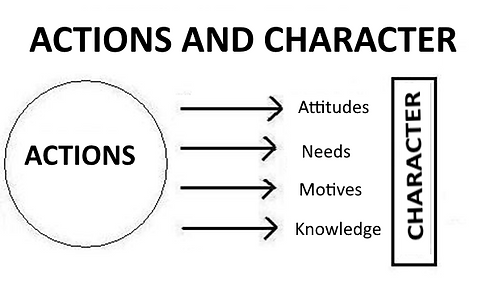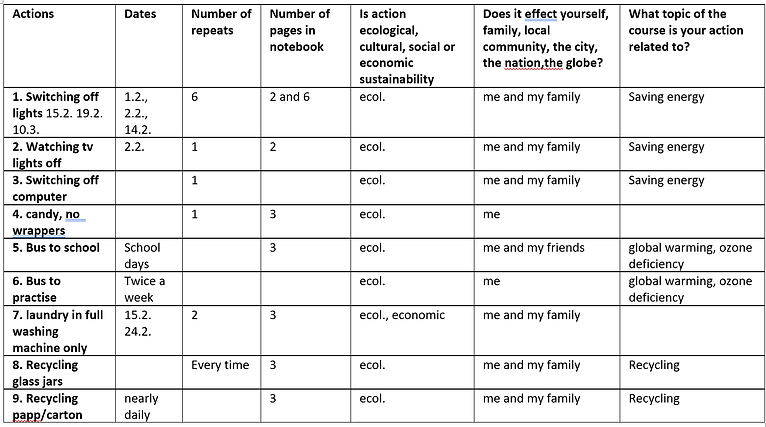SOLVE YOUR PROBLEMS - SAVE THE WORLD
Part 2. A practical approach
Jukka Talvitie
Representative for the Association of Biology and
Geography Teachers in Finland
Annotation: The first article deals with the theoretic background and this second article illuminates a practical approach to cope with the environmental problems and the anxiety they cause to the young people. This approach was implemented in the Käpylä Comprehensive School in Helsinki with the 9th grade pupils. The focus is in giving tools to recognise, handle and solve problems one might be facing in one’s life. These tools include skills such as involvement, participation, self-empowerment, social empowerment and learning for sustainability approaches.
Keywords: Involvement, Participation, Empowerment, Sustainable development, Critical thinking,

...
Young people recognise environmental problems and threats as well as the anxiety these are causing them. We can fight the anxiety with hope. Involvement and participation are prerequisites for environmentally responsible behaviour. The experiences and their reflection influence on person’s environmental actions skills and may lead to self-empowerment or unfortunate disempowerment and rejection. Therefore, the school course is planned in a sequence of alternating phases of acquiring information, learning new skills, taking concrete actions, documenting and evaluating these actions, and going on further to deepen understanding. Thus, the course has cyclical elements of the model of environmental education [1] described in the first article.
-
Starting the course
We start with brainstorming to list problems we might face in our lives. This method helps people to find new ideas, even crazy ones. Pupils come up with problems starting from getting bored with their clothes and ending up with global warming. The next step is to choose, in groups of 2-4 pupils, five most important problems based on brainstorming or on new ideas. Finally, each pupil chooses a problem, which they will try to solve with concrete actions, and again create a list of all the possible ways to solve the chosen problem. This is the first topic of the” Save the World” project. The reason for choosing any possible problem is to raise the level of motivation and later transfer the learned skill to solve an environmental issue.
The grade a pupil receives from the course consists mainly of one’s own project, in which pupils implement and ponder, what they are learning. Pupils are reminded of the basics:
-
The environment provides us with both the material and mental foundations for our culture
-
These foundations are threatened because of the drastic changes in our environment
-
Everyone can do something, but no one can do everything!
Peer assessment and help are used all along the course. Therefore, already at this early point, we check together, what everyone has done to save the world or one’s own problem so far.
2. ”Save the World” is an action project – developing skills to direct one’s own life
Only actions have an impact on the environment. Research also shows that knowledge or attitudes have little to do with one’s environmental behaviour. Therefore, pupils are asked to select problems that they will try to solve, for example, by changing their way of living towards a more sustainable way. They are expected to reflect on their actions while trying to change their habits.
Plan, innovate, act, document, and assess (PIADA)
In order to clarify the idea of studying in this manner, pupils are encouraged to plan, innovate, act, document, and assess their project together during the lessons using the knowledge they learned. They are reminded of keeping a journal/diary of their actions and of collecting information, data sources, newspaper clips, etc. At the end of the course, they will return all the material collected and created during the process. They should think globally and act locally trying to recognise and write down, how their local actions may impact global problems.
Documentation is a key skill in action research: A model for the diary
We use action as the first step for change as it is the only actual tool to solve a problem. Feelings are a source of our motivation and also a reason for losing them. Therefore, we must analyse feelings during the process, since we seek to find motivation by starting the change by acting first. Knowledge has a weak effect on changing our lives, but it tells about understanding the contents.
Action
29.11. I took newspapers for recycling (Parent’s signature, to verify the action taking place)
Feelings
When I started the project two weeks ago, everything felt exhausting, but now it is ok, it has already become a routine for me
Knowledge
Anyway, this saves xx trees, xx liters of water, and xx kWh energy and …
3. Acquiring information on global environmental problems
We started with ozone deficiency for the following reasons. Humanity achieved good results in solving it. It is also a good example of a complex problem. It took decades for people to act after scientists had observed the deficiency and its causes and it still takes years to solve it.
Media literacy
Different sources such as written and electronic articles and other media are used for acquiring knowledge also from the point of view of media literacy, a crucial skill in the modern world. It is often defined in terms of knowledge and skills individuals need to analyse, evaluate, or produce media messages. We are doing this by observing authentic media while acquiring information. We focus on reliability, motivation for producing media, attitudes, and different ways of trying to influence the spectators, for example, music, pictures, colours, etc. Pupils have amazingly developed analytic skills when directing their focus on methods used by media.
Sustainable development
We need to consider all four aspects of sustainable development: Ecological, Economic, Social, and Cultural. Therefore, we try to classify all the actions into the right categories. Pupils are innovative when they are given a chance to use their brains. A group of pupils started to use individual private cafes instead of big chains because they wanted to promote cultural diversity.
Global warming and other topics
We use various methods to study topics such as global warming and biodiversity as well as means of making our ecological footprint smaller: recycling and saving energy. Using fewer chemicals or energy-efficient ways of transport such as walking, or bicycle are also good for our health. The food chain from field to our plate produces approximately 25 % of our emissions promoting climate change. Therefore, it is very important for us to lower the amount of food being wasted.
Although pupils may start their project with any problem in their lives, they widen it to questions of sustainable development. With each topic, we use some time to think, about what practical actions we could take to try to solve them. Pupils are advised to deepen their thinking by implementing their knowledge to the project and explaining the effect of their actions.
4. Going further with the action project
It is vital to guide closely pupils with learning and action projects all through the course by regularly checking the kinds of actions and how far each pupil has come with the project. Sharing ideas and assessing each other’s projects promotes new ideas and motivation for deepening one’s learning. Cloud services give great tools for this. Pupils are asked to report their actions in a joint folder on the internet, in order to give joint support and help to everyone. The idea is to keep personal either in a notebook or in an electronic form, of concrete actions in a cloud open for other users to share ideas with others (Table 1). The list helps teachers to follow the progress and to act with pupils if needed. The list also helps to evaluate the work at the end of the course.
Table 1. An example of a list of actions. Note that thinking needs deepening. In the classroom teacher may easily create discussion about the topics as well as during peer evaluation.
Actions and character – character and actions?
In order to succeed, we need to reflect on our actions. Traditionally we think that our character determines our attitudes, needs, motives, knowledge and further the actions we take. In our project we challenge this idea. Pupils are asked to think in their project the relationship between their character and their actions. (Pic 1 and 2).
-
Has anyone born to become a thief? Think of a child shoplifting just once.
-
Or do you grow up to be a thief by stealing?
Picture 1. Pupils are asked to think of the relationship between their character and their actions. A traditional view is that our character influences our actions.
There is another point of view on the relationship between our actions and character. Maybe the quality of our actions shapes our character and characteristics (attitudes, motives, and needs). If we want to improve our character, we need to start taking actions of higher quality. This is also a good problem-solving method. We simply need to start taking new and better actions. Pupils are advised to apply this approach in their projects. As Mahatma Gandhi said: Be the change you want to see happen.
Picture 2. Pupils are asked to think the relationship between their character and their actions. Maybe the quality of our actions shapes our character and characteristics (attitudes, motives and needs). If we want to improve our character, we need to start taking actions of higher quality.
5. Assessing the Project
In assessing the project, we concentrate on 1. Concrete actions, 2. Depth of thinking in relation to actions and knowledge learned during the course, 3. Problem-solving skills: analysing motivation as well as difficulties and the ways to get passed them. In the middle of the course, there is a halfway assessment done by peers and the teacher, which supports the motivation and actions as well as deepening of pupils’ thinking during the course.
To help and promote quality of self-and peer-assessment there are different sets of questions for each occasion, which you may ask the author. Emphasis is also put on how pupils receive help from peers and how they help others.
Concrete actions
One can make a difference only by taking action – without doing that you will fail this course because only individuals can take action in society, often together. One must think deeply about the relationship between the acquired knowledge during the course and one’s actions and write down what one learns from both ankles. One must keep up working with the actions on a long-term basis: about 1/3 of the actions should last for about 7 weeks. A pupil must fulfill the following criteria from the action point of view for the following grades. In addition to this, a pupil must show considerably deep thinking in written and graphic forms in the project to achieve higher grades.
-
Grade 5: 15 different actions, about half of them will last through the whole course (7 weeks)
-
Grade 7: 30 different actions, about half of them will last through the whole course (7 weeks)
-
Grade 9: 60 different actions, about half of them will last through the whole course (7 weeks)
Depth of Thinking
Pupils should consider what they are doing and why. How does it feel? How do new actions affect their thinking? How does your thinking affect your actions? Is your thinking changing during this course? If so, how is it changing? Consider, what effects your actions have: on yourself, your family, your local community, your city, your nation, and the globe from different aspects of sustainable development.
Conclusions
Planning and directing pupils through the goals of the course, and keeping up their motivation and initiative is both demanding and rewarding. Even parents give feedback on how the project appears at home. Teachers must be able to get the big picture through to the pupils and at the same time guide them with rather small details so that they will better understand the complexity of global problems, how things are intertwined together and how people can act to make things better.
We are fighting anxiety and indifference with optimism, hope, participation, and empowerment. For this, we need a holistic approach connecting all the sides of sustainable development and a pluralistic approach in teaching in order to acknowledge, reflect and discuss different views and perspectives.
Bibliography
-
Paloniemi, R., & Koskinen, S. (2005). Ympäristövastuullinen osallistuminen oppimisprosessina. Terra, 117(1), 17 - 32.


